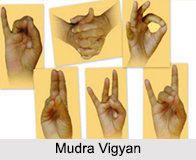 Mudra Vigyan is an entirely distinct and independent branch of Yoga. It is the science of finger postures, based on Yoga of elements that go to create the human body. The science that can help to uplift the human soul and promote to achieve almost divine powers and keep the body perfectly fit. Mudra Vigyan is considered to be a non-medical mode of treatment which is beneficial for the body and mind and at the same time to cure the disease. In Mudra Vigyan, different diseases are treated by holding and retaining the fingers and the thumbs in different ways.
Mudra Vigyan is an entirely distinct and independent branch of Yoga. It is the science of finger postures, based on Yoga of elements that go to create the human body. The science that can help to uplift the human soul and promote to achieve almost divine powers and keep the body perfectly fit. Mudra Vigyan is considered to be a non-medical mode of treatment which is beneficial for the body and mind and at the same time to cure the disease. In Mudra Vigyan, different diseases are treated by holding and retaining the fingers and the thumbs in different ways.
Mudra Vigyan is also a science based on the principles of the Indian Medical Science or Ayurveda which lays down 3 factors primarily responsible for the body"s ills, Vata (wind), Pitta (bile) and Kapha (Phlegm). According to this science, 10 types of Vayus (Winds) circulate through the nerves of the human body and can be controlled with Mudras. Mudra Vigyan is most important aspect of the meditation of the supreme self.
Meaning of Mudra
Mudras are a non-verbal mode of communication and self expression that involves the hand and the fingers. Mudras are of various postures of fingers and thumbs. Mudras are the symbolical expression of inner feelings and inner psychological states. They also generate various qualities such as fearlessness, power, charity and peace in the practitioner and to on lookers. Mudras can cure almost any ailment from a simple ear ache to heart attack. Based on the purpose and practice of mudra, Mudra Vigyan has developed as a science and indeed as an alternative treatment procedure.
Tattva Yoga Mudra
Mudra Vigyan denotes that the 5 fingers are the representation of "Pancha Tattvas". Tattva Yoga Mudra, the 5 fingers of the hand are regarded as representative symbols of these vital elements in the body. The thumbs equate to the source of balancing the flow of "Agni Tattva". The "Vayu Tattva" is determined by the fourth or the index finger. The middle finger in the mudras regulates the "Aakash Tattva" in the body. The ring finger and little finger control the regulation of the "Prithvi" and the "Jala Tattvas" respectively. A proportionate balance of these Tattvas helps the body to perform the natural maintenance of a vigorous body and a happy mind.




















